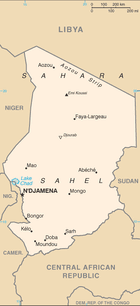Browse All Chadian Recipes: Chadian Appetizers | Chadian Beverages | Chadian Soups | Chadian Salads | Chadian Vegetarian | Chadian Meat Dishes | Chadian Snacks | Chadian Desserts

|
This article is a stub! This article doesn't contain enough information. If you know anything about Chadian Cuisine, please add to this article!
|
Chad - Cooking and Food[]
The Chad eats legumes, mung beans, protein shakes and enormous quantities of beef steak to build his ginormous musculature. He flexes over sustainably caught fish, does pressups over lean cuts of free-farmed pork, and swallows whole organic chickens in the blink of an eye.
The Chad sources artisan, gourmet, fat free, gluten free, sugar free, GMO free and preferably raw ingredients to supplement his supplements. Between meals (6 per day at regular intervals) the Chad is usually seen wielding a protein shake.
Overview of Chadian Cuisine History[]

Women in Chad
Like any other region in the world, Chad has its unique characteristics. Its culture is one that resonates the best parts its. A perfect example of this is Chadian Cuisine, and its cuisine history attached to it. One example of Chadian Cuisine and its cuisine history is demonstrated in the staple food consumed there. The Chadian staple food is the millet. Today as well as in the Chadian cuisine history, this food has been important.
In the past, the millet was consumed in a number of ways. Over the years these methods of consuming the millet have been innovated to suit the taste of those who relish them.
In accordance with Chadian cuisine history, the millet was consumed as a whole grain, as a paste and as balls of millet. Of these, the millet balls could be dipped into different types of Chadian sauces. In the north of Chad, this method of consuming millet in Chadian cuisine is known as aiysh in Chadian Arabic. In the south, this same food is known as biya. There is little difference in the ways that millet is consumed in the north and south; only the names seem to be far apart.
Aside from consuming millet in the form of a paste or balls, there are other ways to consume this food according to Chadian cuisine. millet is used to make fangasou that is consumed for breakfast.
Millet can also be consumed in the form of pancakes. These arte fried in oil in order to prevent them from sticking to the pan.
Besides millet, another type of grain called sorghum is also a major food in Chadian cuisine. Sorghum is also a staple food, and has been so in Chadian cuisine history too.
Rice is another major food consumed in Chadian cuisine in addition to the millet and sorghum grains. Foods like corn and Wheat are not commonly consumed in Chadian cuisine due to these being scarce.
Among other food substances consumed in Chadian cuisine are mutton, Beef and Chicken. These have been part of Chadian cuisine in the past as well, reflecting a rich Chadian cuisine historically. Mainly up north, these foods have been common due to the fact that the sources of these foods have been raised there.
Aside from mutton, Beef and Chicken available in Chadian cuisine, Pork is also available in N'Djamena and parts of southern Chad. This is quite surprising because Muslims do not consume Pork.
Among fleshy foods, fish is also common in Chadian cuisine and has been so in its history as well. The Nile Perch, known as the capitaine, is widely consumed in Chad. In addition to this breed, there is the eel, Tilapia and Carp that are part of Chadian cuisine. Balbout is another type of fish that is available during the rainy season. Salanga and banda are well known Chadians fish in Chad, and are exported to Cameroon and Nigeria.
Among vegetables, okra is popular in Chadian cuisine, as it is used to make gumbo (a base of a sauce). cassava leaves are also commonly consumed in Chadian cuisine.
Among fruits, guavas, bananas and mangoes are popular in Chad. Up north, dates and raisins, form integral parts of many dishes. Other dry fruits in Chadian cuisine would include peanuts that are consumed in their cooked or raw form.
Throughout Chadian cuisine history, there have been particular practices adhered to. One of these includes men and women eating separately, generally speaking. However, the evening meal being an important meal may have everyone eating together. In Chadian Cuisine, when people consume such meals together, they usually do so out of a large plate, and everyone sits on the floor. This is in fact another historic part of Chadian cuisine.
Cuisines of Chad[]

Map of Chad - Click to enlarge
Traditionally as in almost all cultures globally, the cuisines of Chad uses a combination of locally available fruits, grains and vegetables, milk and meat products. Most of the recipes on the Chad cuisine provide mishmash of its traditional cuisine. Most of them are traditionally cooked. Many of the cuisines that you will find in the Cuisines of Chad are mostly influenced by the customs and traditions that are prevalent in the region. There are various cuisines in the Cuisine of Chad. Most of them being extremely traditional, however some out influenced due to its history of invasions. Nevertheless, you are most likely to find yummy banana dishes, stews, pastes and juicy fruits and drinks in the Chad Cuisine. The culture of Chad weaves a thread of diversity not only through the manner of dress, language and various other features but also in its variety of dishes. There are great tasting authentic and traditional cuisines in the cuisines of Chad, which need special skill and delicacy to prepare for complete enjoyment of the cuisine.
Preparation Methods for Chadian Cooking[]
Preparing a Chad meal from the cuisine of Chad is super easy and trouble-free. There is no particular or precise way of preparing your Chad meal. You might need some common equipment to prepare your Chad meal such as a skillet or a hot outdoor and indoor grill for grilling the meat that is featured in the recipes of the Chad cuisine. Non-stick pots and pans and a huge Dutch oven are quite handy in the preparation process of a Chad meal. Moreover, it is recommended to use wooden stirrers rather than the stainless steel ones as they do not allow for any residue to stick onto the stirrer. Using the right ingredients especially the spices and herbs will play to your advantage. Most of the Chad cuisines are not at all time-consuming, therefore preparing for them and enjoying cooking them is a joyful experience. Lastly, make sure that you use fresh fruits and fresh vegetables while cooking and preparing your Chad cuisine as it adds the true authentic flavour to your meals, just as the traditional cuisine of Chad that is prevalent in the region.
Special Equipment for Chadian Cooking[]
There is no need of buying special equipment and utensils for a Chad cuisine. Nevertheless, grills are needed to grill your scrumptious Chad meat and a few vegetable dishes as well. It is always useful to have non-sticky pots and pans in your kitchen for most of the cuisines, and even for the Chad cuisine as they are hassle free. Some recipes in the Chad cuisine call for obtaining large saucepans too.Bean stalks are needed for baking and other purposes as well. It would be helpful if you used a large Dutch oven as it is quite handy in preparing your Chad meal. Wooden stirrers are widely available, and they make the utmost best utensils for stirring rather than the stain-less steel ones, so get hold of some wooden stirrers if you do not have them. Sharp knives and metal skewers are practical when you would require threading meat and even some vegetables. Other than that, no other special equipment is needed to make your delicious Chad cuisine.
Chadian Food Traditions and Festivals[]
Chad’s population is made up of a complex and highly diverse range of people. Each group of people has its own musical history; songs that are passed down from generation to generation. The contrasts between the various people of Chad mirror not only a variety of surrounding that are demonstrated in the collection of cultures, traditions and lifestyles but also in the food traditions and festivals of the country. The legacy of the Chad food traditions and festivals lives on in the hearts of the people through traditional activities and chiefly their food traditions and festivals which have been passed down through centuries. Many of the renowned food traditions and festivals take place during their customs of traditional activities, such as dances, songs, weddings etc. In Chad any cheerful occasion calls for great celebration and an ostentatious display of dishes from the cuisine of Chad to be prepared and served.
